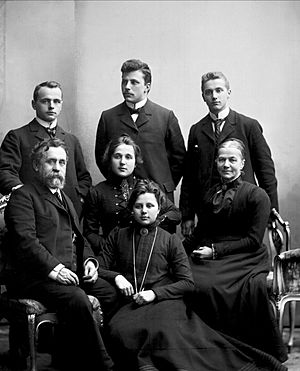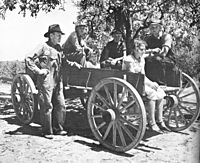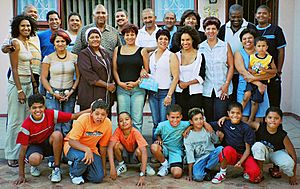Family facts for kids
A family is a group of people who, in most cases, live together. They share their money and food and are supposed to take care of one another. Its members are either genetically related (like brother and sister) or legally bound to each other, for example by marriage. In many cultures, the members of a family have the same or a similar surname.
A family is said to be society´s smallest unit, its nucleus.
Contents
Kinship terminology
Degrees of kinship
A first-degree relative is one who shares 50% of your DNA through direct inheritance, such as a full sibling, parent or progeny.
| Kinship | Degree of relationship by coefficient |
Coefficient of relationship |
Degree of relationship by counting up generations to common ancestor and back down to target individual (used for various genealogical and legal purposes) |
|---|---|---|---|
| Identical twins | 0 | 100% | second-degree |
| Full sibling | first-degree | 50% (2×2−2) | second-degree |
| Parent-offspring | first-degree | 50% (2−1) | first-degree |
| Half-sibling | second-degree | 25% (2−2) | second-degree |
| Grandmother/grandfather | second-degree | 25% (2−2) | second-degree |
| Niece/nephew/aunt/uncle | second-degree | 25% (2×2−3) | third-degree |
| Half Niece/nephew/aunt/uncle | third-degree | 12.5% (2−3) | third-degree |
| First cousin | third-degree | 12.5% (2×2−4) | fourth-degree |
| Half first cousin | fourth-degree | 6.25% (2−4) | fourth-degree |
| Great grandparent | third-degree | 12.5% (2−3) | third-degree |
| First cousin once removed | fifth-degree | 6.25% (2⋅2−5) | fifth-degree |
| Second cousin | sixth-degree | 3.125% (2−6+2−6) | sixth-degree |
Roles
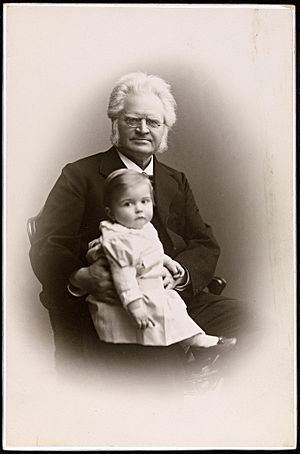
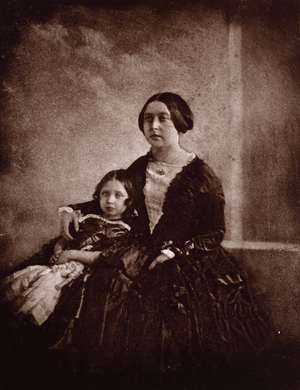
Most Western societies employ Eskimo kinship terminology. This kinship terminology commonly occurs in societies based on conjugal (or nuclear) families, where nuclear families have a degree of relative mobility. Members of the nuclear use descriptive kinship terms:
- Father: a male parent
- Mother: a female parent
- Son: a male child of the parent(s)
- Daughter: a female child of the parent(s)
- Brother: a male sibling
- Sister: a female sibling
- Husband: a male spouse
- Wife: a female spouse
- Grandfather: the father of a parent
- Grandmother: the mother of a parent
- Cousins: two people who share at least one grandparent in common, but none of the same parents.
Such systems generally assume that the mother's husband is also the biological father. In some families, a woman may have children with more than one man or a man may have children with more than one woman. The system refers to a child who shares only one parent with another child as a "half-brother" or "half-sister". For children who do not share biological or adoptive parents in common, English-speakers use the term "stepbrother" or "stepsister" to refer to their new relationship with each other when one of their biological parents marries one of the other child's biological parents. Any person (other than the biological parent of a child) who marries the parent of that child becomes the "stepparent" of the child, either the "stepmother" or "stepfather". The same terms generally apply to children adopted into a family as to children born into the family. In the United States, one in five mothers have children by different fathers; among mothers with two or more children the figure is higher, with 28% having children with at least two different men. Such families are more common among Blacks and Hispanics, and among the lower socioeconomic class.
Members of the nuclear families of members of one's own (former) nuclear family may class as lineal or as collateral. Kin who regard them as lineal refer to them in terms that build on the terms used within the nuclear family:
- Grandparent
- Grandfather: a parent's father
- Grandmother: a parent's mother
- Grandchild
- Grandson: a child's son
- Granddaughter: a child's daughter
For collateral relatives, more classificatory terms come into play, terms that do not build on the terms used within the nuclear family:
- Uncle: parent's brother, or male spouse of parent's sibling
- Aunt: parent's sister, or female spouse of parent's sibling
- Nephew: sibling's son, or spouse's sibling's son
- Niece: sibling's daughter, or spouse's sibling's daughter
When additional generations intervene (in other words, when one's collateral relatives belong to the same generation as one's grandparents or grandchildren), the prefixes "great-" or "grand-" modifies these terms. Also, as with grandparents and grandchildren, as more generations intervene the prefix becomes "great-grand-," adding another "great-" for each additional generation. Most collateral relatives have never had membership of the nuclear family of the members of one's own nuclear family.
- Cousin: the most classificatory term; the children of uncles or aunts. One can further distinguish cousins by degrees of collaterality and by generation. Two persons of the same generation who share a grandparent count as "first cousins" (one degree of collaterality); if they share a great-grandparent they count as "second cousins" (two degrees of collaterality) and so on. If two persons share an ancestor, one as a grandchild and the other as a great-grandchild of that individual, then the two descendants class as "first cousins once removed" (removed by one generation); if they shared ancestor figures as the grandparent of one individual and the great-great-grandparent of the other, the individuals class as "first cousins twice removed" (removed by two generations), and so on. Similarly, if they shared ancestor figures as the great-grandparent of one person and the great-great-grandparent of the other, the individuals class as "second cousins once removed". Hence one can refer to a "third cousin once removed upwards."
Cousins of an older generation (in other words, one's parents' first cousins), although technically first cousins once removed, are often classified with "aunts" and "uncles." Similarly, a person may refer to close friends of one's parents as "aunt" or "uncle," or may refer to close friends as "brother" or "sister," using the practice of fictive kinship. English-speakers mark relationships by marriage (except for wife/husband) with the tag "-in-law." The mother and father of one's spouse become one's mother-in-law and father-in-law; the female spouse of one's child becomes one's daughter-in-law and the male spouse of one's child becomes one's son-in-law. The term "sister-in-law" refers to three essentially different relationships, either the wife of one's sibling, or the sister of one's spouse, or, in some uses, the wife of one's spouse's sibling. "Brother-in-law" expresses a similar ambiguity. The terms "half-brother" and "half-sister" indicate siblings who share only one biological or adoptive parent.
Types of kinship
Patrilineal
Patrilineality, also known as the male line or agnatic kinship, is a form of kinship system in which an individual's family membership derives from and is traced through his or her father's lineage. It generally involves the inheritance of property, rights, names, or titles by persons related through male kin.
A patriline ("father line") is a person's father, and additional ancestors that are traced only through males. One's patriline is thus a record of descent from a man in which the individuals in all intervening generations are male. In cultural anthropology, a patrilineage is a consanguineal male and female kinship group, each of whose members is descended from the common ancestor through male forebears.
Matrilineal
Matrilineality is a form of kinship system in which an individual's family membership derives from and is traced through his or her mother's lineage.
It may also correlate with a societal system in which each person is identified with their matriline—their mother's lineage—and which can involve the inheritance of property and titles. A matriline is a line of descent from a female ancestor to a descendant in which the individuals in all intervening generations are mothers - in other words, a "mother line".
In a matrilineal descent system, an individual is considered to belong to the same descent group as her or his mother. This matrilineal descent pattern is in contrasts to the more common pattern of patrilineal descent pattern.
Bilateral descent
Bilateral descent is a form of kinship system in which an individual's family membership derives from and is traced through both the paternal and maternal sides. The relatives on the mother's side and father's side are equally important for emotional ties or for transfer of property or wealth. It is a family arrangement where descent and inheritance are passed equally through both parents. Families who use this system trace descent through both parents simultaneously and recognize multiple ancestors, but unlike with cognatic descent it is not used to form descent groups.
Traditionally, this is found among some groups in West Africa, India, Australia, Indonesia, Melanesia, Malaysia and Polynesia. Anthropologists believe that a tribal structure based on bilateral descent helps members live in extreme environments because it allows individuals to rely on two sets of families dispersed over a wide area.
Related pages
Images for kids
-
Sauk family photographed by Frank Rinehart in 1899
-
Mennonite siblings, Montana, United States, 1937
-
Settled Sami (Lapplander) family of farmers in Stensele, Västerbotten, Sweden, early 20th century
-
Hispanic family eating a meal.
-
A family from Basankusu, Democratic Republic of the Congo.
-
The family of Finnish statesman J. K. Paasikivi (right) in 1906
See also
 In Spanish: Familia para niños
In Spanish: Familia para niños


